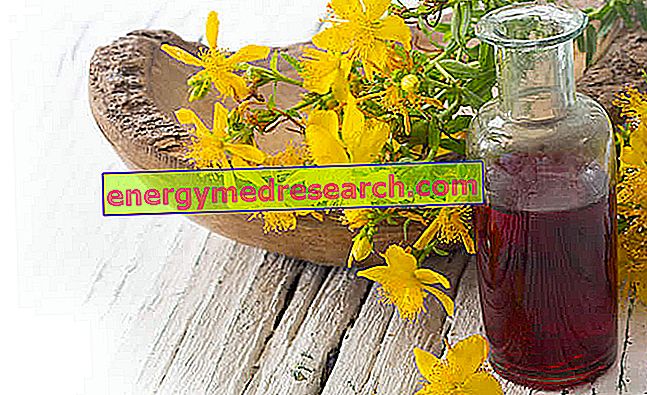What is that
Hypericum oil is an oleolite obtained from fresh flowers of Hypericum perforatum, a plant belonging to the Hypericaceae family, also known as Erba di San Giovanni .
Appreciated for the numerous effects exerted on injured and irritated skin, hypericum oil is widely used in the phytotherapeutic field for the treatment of various skin disorders.

Oil and Essential Oil: a bit of clarity
The word "hypericum oil" could cause confusion, since from the plant it is possible to obtain also an essential oil and a fixed oil.
However, when we talk about hypericum oil we commonly refer to the oleolite obtained by maceration in vegetable oil of the flowers and aerial parts of the plant.
The essential oil is also obtained from the flowers and from the aerial parts of hypericum, but through a distillation in a current of steam; while the aforementioned fixed oil is obtained from the seeds of the plant.
Preparation
Preparation of Hypericum Oil
Hypericum oil can be prepared in different ways.
The most common methods involve the maceration of the fresh flowers of the plant in olive oil (ratio 25: 100), or in sunflower oil. However, it is also possible to use other parts of the plant (such as buds, leaves or all aerial parts), just as it is possible to vary the type of vegetable oil used for maceration (linseed oil, corn oil, etc.).
To guarantee an excellent extraction of active substances, maceration should take place in the sunlight for a specific time. However, this time can vary depending on the method and the "ingredients" used. In fact, according to some authors, it is sufficient to let the flowers soak in the sun until the oily mixture takes on a red color (normally, this occurs within a few days); others, however, suggest that maceration should continue for at least a month.
In any case, it is possible to find ready-made hypericum oil on the market, and above all, prepared according to strict quality standards, in order to guarantee its effectiveness and safety in use.
Features and Composition
Features and Composition of Hypericum Oil
Hypericum oil is a clear liquid with a typical red color, sometimes amber. The characteristics of the oil, however, may vary depending on the method of maceration used, the parts of the plant used and their freshness, and depending on the type of oil used.
The composition of the hypericum oil is given both by the substances contained in the vegetable oil used for the maceration, and by the substances that the latter has extracted from the plant. Also in this case, of course, the oil composition may vary depending on the method used.
However, among the main components of hypericum oil, we find:
- Triglycerides and fatty acids (provided by the vegetable oil used for extraction);
- Flavonoids;
- Acylfloroglucinols, among which hyperforin stands out;
- Flavonoids, such as quercitrin and isoquercitrina.
Hypericin - the anthraquinone derivative attributed to the anti-inflammatory, but also photosensitizing properties of hypericum - is usually not present in industrially produced hypericum oil, nor in that produced with traditional methods. This absence is probably due to the instability of this substance, which leads to its rapid degradation when exposed to light and air.
Property
Properties of Hypericum Oil
Thanks to its particular and rich composition, hypericum oil boasts a series of properties that make it an excellent natural remedy for the treatment of various skin disorders.
More precisely, properties of hypericum are attributed to:
- eudermic;
- Dermorestitutive;
- Emollients;
- soothing;
- Anti inflammatory;
- antiseptic;
- Cicatrizant.
In particular, these last properties are mainly attributable (but not exclusively) to the hyperforin contained in the plant.
uses
St. John's wort oil is used in the phytotherapy and cosmetic field for the treatment of various skin disorders, both mild and moderate. More precisely, by virtue of its multiple properties, hypericum oil is particularly indicated in case of dry and reddened skin, sunburn, minor burns and small burns. Furthermore, St. John's wort oil can be useful to promote the healing of small wounds and sores.
Please note
After applying St. John's wort oil, as a precautionary measure, exposure to UV rays is not recommended. In fact, even if hypericin is not present inside the product, the possibility of onset of photosensitivity reactions cannot be ruled out entirely.
Hypericum oil is for external use only, therefore, under no circumstances should it be ingested.
On the market, there are specific products based on hypericum suitable for oral administration (supplements and drugs) and with indications different from those listed so far (depressive states and improved mood).
Side effects
Normally, hypericum oil is well tolerated by all skin types and, for this reason, no particular side effects caused by its use are known. However, there is the possibility of allergic reactions occurring in sensitive individuals. These reactions can occur with the appearance of symptoms such as redness, itching, burning, rash and edema.
Contraindications
The use of hypericum oil is contraindicated in case of known hypersensitivity to any of its components.



